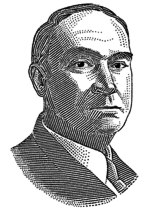FILSON – RUGGED QUALITY FOR OVER 100 YEARS
Born in 1850, C. C. Filson inherited his father’s pioneer spirit and love of the outdoors. After  homesteading in Nebraska and roaming the country as a railroad conductor, he moved to the small city of Seattle, Washington in the 1890’s.
homesteading in Nebraska and roaming the country as a railroad conductor, he moved to the small city of Seattle, Washington in the 1890’s.
Filson’s timing couldn’t have been better. By 1897, the Great Klondike Gold Rush was on, and thousands of fortune hunters were stampeding into Seattle, headed north. Armed with a strong work ethic, a reputation for honesty, and several years’ experience operating a small loggers’ outfitting store, C. C. Filson was ready to stake his claim to fame.
“TO OUR CUSTOMERS: if a man is going North, he should come to us for his outfit, because we have obtained our ideas of what is best to wear in that country from the experience of the man from the North — not merely one — but hundreds of them. Our materials are the very best obtainable, for we know that the best is none too good and that quality is of vital importance. YOU CAN DEPEND ABSOLUTELY UPON OUR GOODS BOTH AS TO MATERIAL AND WORKMANSHIP.”
— C.C. Filson, 1914 Catalog
THE GOLD RUSH YEARS: 1897-1899
In 1897, Filson opened C.C. Filson’s Pioneer Alaska Clothing and Blanket Manufacturers, specializing in goods to outfit the stampeders to the Klondike Gold Rush.
Stories of harrowing experiences in the Yukon were widely reported. The diary of Hume Nisbet, 1897 painted this picture: “Try to recall your sensations on the coldest night you have ever known: try to intensify the most bitter ice blast that has ever pierced your marrow by a thousandfold; even then you will not be able to realize spring in the Chilkoot Canyon, far less midwinter on the Klondike.”
It was for these terrible conditions that Filson designed his goods. He owned his own mill and manufactured Mackinaw clothing, Mackinaw blankets and knit goods, as well as selling boots, shoes, moccasins and sleeping bags specially designed for the frigid North. Filson kept in close contact with his customers, improving his goods to meet their specific needs. The stampeders depended on Filson. In that era, clothing wasn’t a matter of choice, but of survival.
TOUGH, COMFORTABLE OUTDOOR CLOTHING FOR HUNTERS AND FISHERMEN, ENGINEERS AND EXPLORERS, MARINERS AND MINERS.
The Gold Rush faded into history, but Filson kept listening to his customers, and outdoorsmen kept coming to Filson for rugged clothes. Drawing from his past experience outfitting loggers, he soon added clothing for the timber industry, including the Filson Cruiser, the garment that was to earn Filson a place in history. Designed and named by C.C. Filson and patented on March 3, 1914, US Patent #1088891, the Cruiser has remained Filson’s best selling item. Today, Filson has sold over half a million of this trademark coat.
WORLDWIDE REPUTATION FOR HONESTY, QUALITY AND DURABILITY
Filson continued to make his goods from the best materials obtainable, and guaranteed every piece of merchandise. If he didn’t stock an item a customer needed, he custom-made it for him. Filson’s name became synonymous with reliability, satisfaction and honest values. By the 1960s, Filson’ reputation as the premier outfitter for outdoorsmen had spread around the globe. In addition to being stocked by retailers of quality outdoor wear, Filson garments were being ordered by mail from places as far away as Greenland.
“The goods we quote must not be confounded with the cheap and vastly inferior grade with which the market is over-run. Such goods are not only useless for the purpose for which they are intended, but the person wearing them would be better off without them.”
— Clinton C. Filson 1914 catalog
WHAT WORKED THEN, STILL WORKS NOW
Over the years, Filson’s philosophy has never changed: make sure it’s the absolute best. Clinton Filson spent a lot of time talking to his customers and refining his designs to their specifications. So it’s not surprising that the items that worked then still work today, over 100 years later. Comfort, protection and durability never go out of style.
1897 |
Klondike gold seekers come to C.C. Filson for rugged outfits to survive -50 cold. | |
1902 |
Loggers line up for Filson’s new clothing line for loggers. | |
1914 |
Patent is granted for Filson Cruiser coat, still made and sold today. | |
1927 |
Filson Cruiser becomes copied extensively when patent expires. | |
1941 |
Filson expands its line of boots. | |
1945 |
U.S. Forest Service commissions new water repellent garments, dyed Forestry Green. | |
1985 |
Factory moves to Seattle’s historic Pioneer Square, 5 blocks from original 1897 store. | |
1991 |
Luggage line is re-introduced, made of Rugged Twill and Bridle Leather. | |
1996 |
Fly fishing vests are introduced after 10 years of research and development. | |
1998 |
New lodge-like store opens in historic building 10 blocks from original location. | |
2003 |
Original Wool Shirt made of 100% virgin Merino wool is introduced. | |
2005 |
New Recoil Pad Technology introduced in our Super Shooting Shirts and in several of Shooting and Hunting Outerwear products. New, easier to use website introduced. |
- http://www.filson.com/filson/our-company/history/